|
 |
ESSENTIALS
|
Currency
The Peso presently values between 9-10 Pesos to 1 US dollar. The Bancomer, Banamex & Banco Internacional banks on Mar de Cortez generally have the best exchange rates & usually do money exchanges between 9-11am, Monday through Friday. You won't find any private money exchanges or "casa de cambios" in San Felipe, but you will in Mexicali & Calexico if you drive down.
The Bancomer has an ATM machine which is available to the tourist, but it is unreliable and has been known to be "down" for hours at a time. You will be paid in pesos. Some banks will allow you to have cash advances on your VISA & MasterCard, but don't rely on it. Your best bet is to have both dollars & pesos on hand when you arrive.
Almost every establishment - from restaurants to shops, will readily accept U.S. currency. The town's businesses being so close to the border will often have U.S. dollar prices listed. The issue in that
case will be the exchange rate that they offer; it is advisable to ask first in order to avoid any
disappointments. Also, whether paying in Dollars or in Pesos, it is a good idea to carry small bills with
you, as it is often difficult for small shops or stands to make change for large bills. Don't expect a $50 or $100 bill to be cashed everywhere.
Credit Cards
Most of the hotels, resorts and more upscale restaurants and shops will accept credit cards, with some or
no surcharge, although the exchange rate may be little less than preferable. However, you have to keep in mind is that many other establishments - especially smaller
ones with lower prices, do not accept credit cards. While you are planning your trip, make sure that you
carry - or have access to, enough cash or traveller's checks.
Time & Pace
San Felipe is in the Pacific Time Zone.
It is said that the pace of life is generally slower in Mexico. At times it
is true! Due to the hot temperatures in summer months, the residents of this area (Mexicans and Non-
Mexicans alike) have learned to slow down and pace themselves - especially when working outside under the sun. Many leave for cooler climates during July & August when temperatures reach the 100's.
Siesta or the midday break is a tradition that reflects the necessity of avoiding heat-related fatigue. It coincides with the hottest time of
day when people retreat to their homes to eat and rest in the shade. However, you won't see many businesses closed for "siesta", except during slow weeks or in the summer, as in the rest of Mexico. This can be attributed to the town's proximity to the U.S.
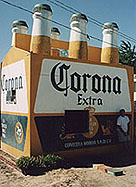
Famous roadside liquor store |
GETTING
HERE
|
San Felipe can be reached by land, air or sea. Driving is the most common method of transportation. Bring your identification when you visit, but a passport or tourist card are not required. You will need a tourist card if you plan to stay more than 72 hours (3 days). Pick up a tourist card at the border or your nearest consulate. You must however have insurance for your vehicle or boat if you cross the border. Please see the Professional Directory for local companies.
By Land
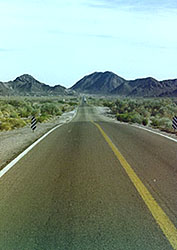
The road to San Felipe |
Driving is the choice of most visitors to San Felipe. The town can be accessed by two roads, either by the Highway 5 from Mexicali or Highway 3 from Ensenada. The Mexicali route begins in the thriving capital and leads past the Colorado River Delta and into the desert surrounding San Felipe. The trip usually takes about 2 hours. From Ensenada, you'll climb into the mountains which form the backbone of the Baja peninsula. |
You'll pass though the green valleys surrounding the town of Ojos Negros & Valle de la Trinidad eventually coming down into the desert at Crucero La Trinidad, the intersection of Hwy 3 & Hwy 5. This trip usually takes 2 1/2 hours.
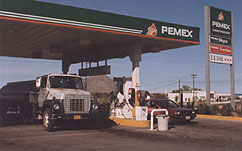
A Pemex gas station in San Felipe
Either route you take shows the unique beauty of Baja California and is quite enjoyable. Both Hwy. 3 & Hwy. 5 have Mexican army checkpoints. Don't be alarmed, they are friendly and are only checking for guns & drugs, both mandatory jail time offenses in Mexico. They'll usually have you through the check point in 5 minutes or less.
Call Sr. Jose Luis for details on Caravans from the U.S. border (Calexico-Mexicali) to San Felipe at 011-52 (657) 7-1277 or 7-1278. You may also receive details at (303) 790-1749 in the U.S..
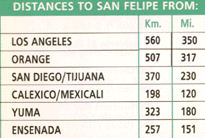
There is also a "highway" that extends south of San Felipe that will take you to the village of Puertecitos located 90km (about 60 miles) away. But because this highway is not in top condition due to lack of maintenance, it is recommended to use caution if you are driving a standard vehicle.
You may also take a bus from Mexicali, Tijuana or Ensenada. It is the most economical method of travel, but may take longer than driving. The main Bus Station is located on Ave. Mar Caribe about 6 blocks from the beach. The cost to & from Mexicali is in the $7-$8 range.
By Air
The city of San Felipe has an international airport that is operated by the State Government. Call the Tourism Department for up-to-date information. It is located 12km. south of the population of the town with a paved access road directly to and from the airport. The airport has the following infrastructure:
- Runway
- Control Tower
- Fuel
- Terminal and waiting room (capacity for up to 100 people)
- Customs and Inspection area
- Parking
- Taxi Service
- Tower Frequency - 118.5 SFE
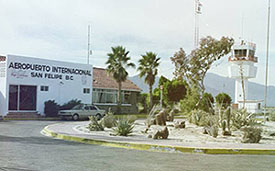
San Felipe Airport office & tower
The airport usually handles small private aircraft and currently does not offer commercial flights.
By Sea
There is a port and a wharf in San Felipe with it's traffic being principally the local shrimp fishermen. They do, however, get an occasional yacht and recreational boats. Contact the Captain of the Port upon docking for information.
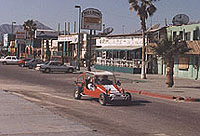 |
GETTING OUT
&
ABOUT
|
During your stay in San Felipe transportation requirements will be dictated by where you are staying and where your intended destination is. Since many people drive to town, their need of local travel are met. You will, however, have some options such as taxis and ATV rentals.
Getting Around
Most hotels are within walking distance of the center of San Felipe. If you plan to travel great distances, visit remote beaches, are staying at one of the outer hotels or just don't feel like walking, taxis are by far the best way to get around. Taxis are plentiful, clean and reliable, and fares are reasonable and fixed. Your hotel can usually call you a taxi or you can find them cruising up Mar de Cortez or the Malecon. San Felipe does not have a city bus system as many other Mexican towns do.
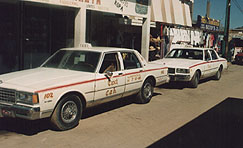
You'll find taxis along the main streets
Dune buggy's & ATV's can be rented for the hour, day or weekend if you are prepared to have a fun & exciting form of transportation while in town. You'll see rental stands throughout town.
Your last option is the "water taxi" or local panga (fishing skiff). You can usually flag down a passing fisherman from the beach and ask him to shuttle you to town. Most of these friendly pescaderos will gladly take you to your destination & depending on the distance and how many people are riding, the price is usually a dollar or two per person for a fun ride along the shore of San Felipe.
|